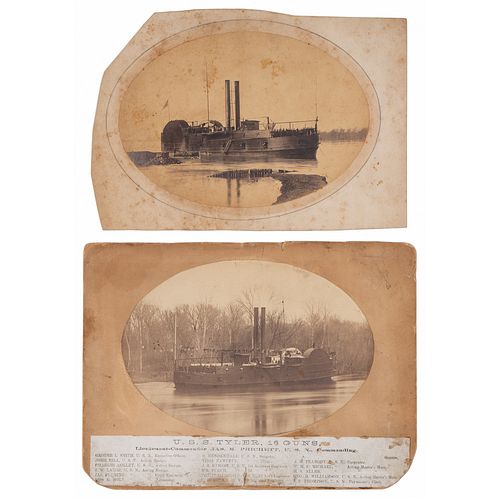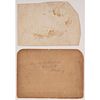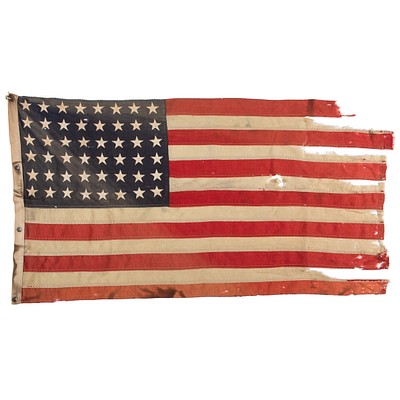USS Tyler, Two Albumen Photographs of Brown Water Navy Gunboat
About Seller
6270 Este Ave.
Cincinnati , OH 45232
United States
With offices in Cincinnati, Cleveland and Denver, Cowan’s holds over 40 auctions each year, with annual sales exceeding $16M. We reach buyers around the globe, and take pride in our reputation for integrity, customer service and great results. A full-service house, Cowan’s Auctions specializes in Am...Read more
Two ways to bid:
- Leave a max absentee bid and the platform will bid on your behalf up to your maximum bid during the live auction.
- Bid live during the auction and your bids will be submitted real-time to the auctioneer.
Bid Increments
| Price | Bid Increment |
|---|---|
| $0 | $25 |
| $500 | $50 |
| $1,000 | $100 |
| $2,000 | $250 |
| $5,000 | $500 |
| $10,000 | $1,000 |
| $20,000 | $2,500 |
| $50,000 | $5,000 |
| $100,000 | $10,000 |
About Auction
Jun 26, 2020
Cowan's Auctions is delighted to present the June 26 American Historical Ephemera and Photography Auction, including 55 lots devoted to the African American experience, over 175 lots dating from the Civil War Era, and more than 60 lots documenting life in the American West. Cowan's Auctions dawnie@cowans.com
- Lot Description
USS Tyler, Two Albumen Photographs of Brown Water Navy Gunboat
Lot of 2. Oval albumen photograph, approx. 7.5 x 5.5 in., mounted to approx. 9.75 x 7.5 in., featuring the USS Tyler. Uncredited, n.d. Affixed printed caption lists names and ranks of the ship's officers. Various pencil inscriptions on verso including the name "John Powers 2nd Boatswainsmate [sic]" suggesting original ownership by a member of Tyler's crew. Oval albumen photograph, 5.25 x 7.5 in., on poorly trimmed mount, 6.25 x 9.25 in., of USS Tyler taken from the port side with crewmen relaxing on the bow. J.W. Taft: Memphis, TN, April 10, 1865. Small photographer's stamp on verso.
The A.O. Tyler (built 1857) was a commercial side-wheel steamboat taken over by the Navy and commissioned in September 1861 as the gunboat USS Tyler. The Tyler saw early service on the upper Mississippi transporting troops under U.S. Grant in the abortive attack on Belmont, Missouri, later joining in the bombardment of Columbus, Kentucky. She aided in the capture of Forts Henry and Donelson while simultaneously engaged in aggressive patrolling of the Tennessee River that resulted in the capture of three incomplete Rebel gunboats, notably the CSS Eastport on February 7, 1862. During a desperate moment at the Battle of Shiloh on April 6 the gunboats Tyler and Lexington were instrumental in securing the left of the hard pressed Union line with "devastating enfilade fire that forced the Southern right flank to fall back" allowing Grant to stage a counterattack next day. Wrote Grant, "in this repulse much is due to the presence of the gunboats." On April 19 Tyler captured a Confederate transport on the river and burned another. For the next fourteen months Tyler was engaged in various operations, both navy and army, that culminated with the capture of fortress Vicksburg. Of particular note, in mid-July 1862 Tyler led a contingent of warships on the Yazoo to locate and engage the Rebel ram CSS Arkansas, reported as still incomplete. On July 15 General Quarters sounded as billowing smoke from Arkansas's funnel was spotted. A short but heavy cannonade commenced with Arkansas quickly disabling the USS Carondelet. USS Queen of the West healed and disengaged leaving the timberclad Tyler to face the enemy ironclad alone. Tyler was forced to turn and retreat down the Yazoo with Arkansas steaming as fast as her faulty engines allowed, the two vessels exchanging intermittent fire. Disaster was only averted as Tyler came under the protective guns of the rest Union fleet moored at the confluence of the rivers. Such was the trajectory of Arkansas that she "ran through (them), delivering salvo after salvo into the aggregate of Union ships" before coming to anchor beneath the guns of the Vicksburg water batteries.
USS Tyler was noteworthy in operations underlying the capture of Arkansas Port and Haines Bluff mentioned before as well as Helena, Arkansas where she brought her guns "to bear on an attacking Confederate force." During the first half of 1864 Tyler steamed principally on the White River taking part in the bombardment of Confederate batteries near Clarendon, Arkansas on June 24 after which combat operations on the Mississippi and its tributaries gradually subsided. At the end of the war USS Tyler, with a volunteer crew (the wartime complement having already been discharged), assisted in the rescue of numerous survivors - many of whom were former Andersonville inmates - of the Sultana explosion that occurred north of Memphis on April 27, 1865. Tyler was then laid up at Mound City in June until the Navy sold her at auction on August 17, 1865.
Provenance: The Richard B. Cohen Civil War CollectionBoth oval albumens undamaged with strong clarity, near EXC. Black Hawk with portion of left margin of mount completely trimmed away with the two right corners dented. Tyler mount soiled with all four corners rounded, bottoms actually trimmed, and top edge worn and rough. Properly matted presentation of both photographs would improve.Condition
- Shipping Info
-
Buyers are required to pay for all packing, shipping and insurance charges. Overseas duty charges are the responsibility of the successful Bidder. Be aware that for larger and/or valuable items, shipping charges can be substantial. - If there is no shipping amount on listed your invoice, you will need to make arrangements to pick up or ship your purchase through an alternative shipping company. Our shipping department can be contacted at 513.871.1670 (ext. 219) or email shipping@cowans.com. - Shipping charges include insurance for your order while in transit. If you have private insurance we will adjust your charge to include only packing and shipping. - Please allow 14 – 21 days after payment to package and ship your purchase as carefully as possible.
-
- Buyer's Premium



 EUR
EUR CAD
CAD AUD
AUD GBP
GBP MXN
MXN HKD
HKD CNY
CNY MYR
MYR SEK
SEK SGD
SGD CHF
CHF THB
THB






![[MEDICAL HISTORY] Craig Gutta-Percha Microscope Base](https://s1.img.bidsquare.com/item/m/2904/29046456.jpeg?t=1Ttr6w)
![[CIVIL WAR] William T. Sherman CDV Portrait](https://s1.img.bidsquare.com/item/m/3259/32590994.jpeg?t=1UVtrf)
![[LINCOLN] Abraham & Mary Todd CDV Portraits](https://s1.img.bidsquare.com/item/m/3194/31943004.jpeg?t=1UDVtx)
![[THEODORE ROOSEVELT] Naval Commission, 22 May 1908](https://s1.img.bidsquare.com/item/m/3258/32582659.jpeg?t=1UUDch)
![[LINCOLN] 1860 Benjamin Grierson Composed Anti-Slavery Songsheet](https://s1.img.bidsquare.com/item/m/3150/31508307.jpeg?t=1Urgsc)
![[LINCOLN] 8th IL Cav. Vet Met Lincoln](https://s1.img.bidsquare.com/item/m/3150/31503939.jpeg?t=1UreKU)
